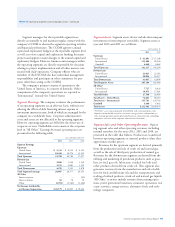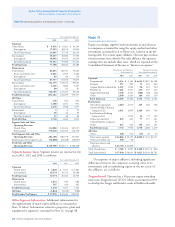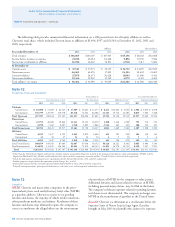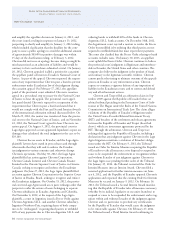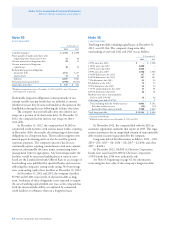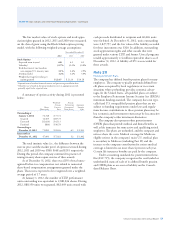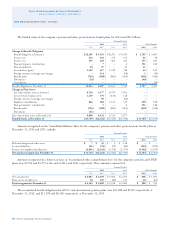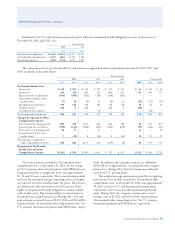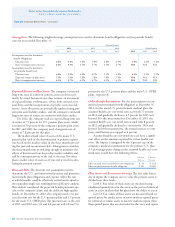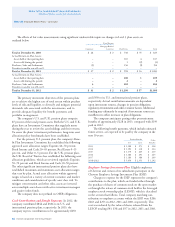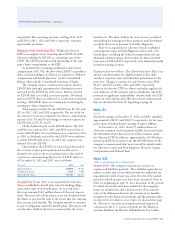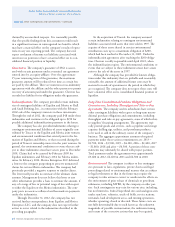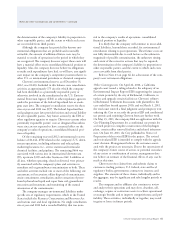Chevron 2012 Annual Report Download - page 57
Download and view the complete annual report
Please find page 57 of the 2012 Chevron annual report below. You can navigate through the pages in the report by either clicking on the pages listed below, or by using the keyword search tool below to find specific information within the annual report.
Chevron Corporation 2012 Annual Report 55
e following table indicates the changes to the company’s
suspended exploratory well costs for the three years ended
December 31, 2012:
2012 2011 2010
Beginning balance at January 1 $ 2,434 $ 2,718 $ 2,435
Additions to capitalized exploratory
well costs pending the
determination of proved reserves 595 652 482
Reclassications to wells, facilities
and equipment based on the
determination of proved reserves (244) (828) (129)
Capitalized exploratory well costs
charged to expense (49) (45) (70)
Other reductions* (55) (63) –
Ending balance at December 31 $ 2,681 $ 2,434 $ 2,718
*Represents property sales.
e following table provides an aging of capitalized well
costs and the number of projects for which exploratory well
costs have been capitalized for a period greater than one year
since the completion of drilling.
At December 31
2012 2011 2010
Exploratory well costs capitalized
for a period of one year or less $ 501 $ 557 $ 419
Exploratory well costs capitalized
for a period greater than one year 2,180 1,877 2,299
Balance at December 31 $ 2,681 $ 2,434 $ 2,718
Number of projects with exploratory
well costs that have been capitalized
for a period greater than one year* 46 47 53
* Certain projects have multiple wells or elds or both.
Of the $2,180 of exploratory well costs capitalized for
more than one year at December 31, 2012, $1,359 (23 proj-
ects) is related to projects that had drilling activities under
way or rmly planned for the near future. e $821 balance
is related to 23 projects in areas requiring a major capital
expenditure before production could begin and for which
additional drilling eorts were not under way or rmly
planned for the near future. Additional drilling was not
deemed necessary because the presence of hydrocarbons had
already been established, and other activities were in process
to enable a future decision on project development.
Note 17
New Accounting Standards
Balance Sheet (Topic 210) Disclosures about Osetting
Assets and Liabilities (ASU 2011-11) In December 2011,
the FASB issued ASU 2011-11, which became eective for
the company on January 1, 2013. e standard amends and
expands disclosure requirements about osetting and related
arrangements. e company does not anticipate any impacts
to its results of operations, nancial position or liquidity
when the guidance becomes eective.
Comprehensive Income (Topic 220) Reporting of
Amounts Reclassied Out of Accumulated Other Com-
prehensive Income (ASU 2013-02) e FASB issued ASU
2013-02 in February 2013. is standard became eective
for the company on January 1, 2013. ASU 2013-02 changes
the presentation requirements of signicant reclassications
out of accumulated other comprehensive income in their
entirety and their corresponding eect on net income. For
other signicant amounts that are not required to be reclas-
sied in their entirety, the standard requires the company to
cross-reference to related footnote disclosures. Adoption of
the standard is not expected to have a signicant impact on
the company’s nancial statement presentation.
Note 18
Accounting for Suspended Exploratory Wells
Accounting standards for the costs of exploratory wells (ASC
932) provide that exploratory well costs continue to be capi-
talized after the completion of drilling when (a) the well has
found a sucient quantity of reserves to justify completion
as a producing well, and (b) the entity is making sucient
progress assessing the reserves and the economic and operat-
ing viability of the project. If either condition is not met or
if an enterprise obtains information that raises substantial
doubt about the economic or operational viability of the proj-
ect, the exploratory well would be assumed to be impaired,
and its costs, net of any salvage value, would be charged to
expense. (Note that an entity is not required to complete the
exploratory well as a producing well.) e accounting stan-
dards provide a number of indicators that can assist an entity
in demonstrating that sucient progress is being made in
assessing the reserves and economic viability of the project.


